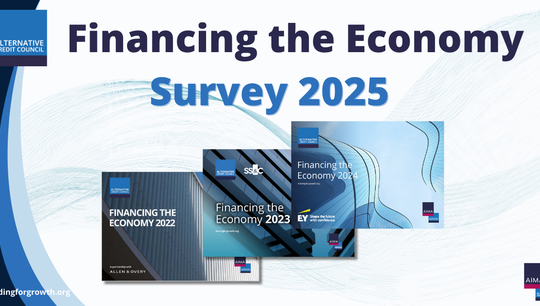Ep. 29 The Long-Short | Exploring ESG in private markets, with Preqin
Published: 01 June 2022
The Long-Short is a podcast by the Alternative Investment Management Association, focusing on the very latest insights on the alternative investment industry.
Each episode will examine topical areas of interest from across the alternative investment universe with news, views and analysis delivered by AIMA’s global team, as well as a host of industry experts.
This week, we speak to Jaclyn Bouchard, Head of ESG at Preqin, to compare the challenges of applying ESG principles to private and public markets.
Listen to this episode and subscribe on Spotify
Listen to this episode and subscribe on Apple Podcasts
Listen to this episode and subscribe on Google Podcasts
Listen to this episode and subscribe on Amazon Music
Read the transcript:
Hosts: Tom Kehoe, AIMA; Drew Nicol, AIMA,
Guests: Jaclyn Bouchard, EVP, Head of ESG Solutions & Corporate Responsibility at Preqin
Tom Kehoe, AIMA 00:05
Hello and welcome to The Long-Short, a new podcast brought to you by AIMA the Alternative Investment Management Association, focusing on the very latest insights on hedge funds and private credit. My name is Tom Kehoe. AIMA is the global representative of the Alternative Investment Industry with around 2,000 corporate members spread across 60 countries. Of these are fund manager members account for approximately two and a half trillion dollars in hedge fund and private credit assets. Each weekly episode of The Long-Short will examine topical areas of interest from across the alternative investment universe, with news views and analysis delivered by AIMA's global team, as well as a host of industry experts. So, whether you're a hedge fund or private credit industry veteran, a student of the industry, or just someone interested in learning more about hedge funds and private credit, this podcast will be your ideal companion to help you navigate to the long and short of this fascinating industry.
Tom Kehoe - Hello and welcome to episode 29 of The Long-Short. This week we speak to Jaclyn Bouchard head of ESG at Preqin to compare the challenges of applying ESG principles to private and public markets. So much of the discussion today around ESG completely ignores the very different ecosystem that private market investment strategies operate in, usually typified by the much lighter regulatory requirements for companies to report data that could be used for ESG metrics.
Drew Nicol, AIMA 01:28
And with interest in exposure to private markets among hedge funds and investors booming right now, this makes today's discussion very timely for those of us looking to better understand how far ESG has come and being implemented and what tools are available to measure it.
Jaclyn offered some excellent insights on exactly where the drive for greater transparency around ESG is coming from. And also she gave some really interesting examples of case studies where market participants have taken their own initiative to create ESG protocols instead of waiting for regulators to lay down new laws.
Tom Kehoe, AIMA 02:01
And as she notes we are right at the beginning of this journey when it relates to private markets. And it's certainly a trend to watch going forward. So without further ado, here's our discussion with Preqin’s Jaclyn Bouchard. We hope you enjoy it.
Jaclyn Bouchard, you're very welcome to The Long-Short!
Jaclyn Bouchard; Preqin 02:21
Thank you. Thanks for having me.
Tom Kehoe, AIMA 02:23
So, Jaclyn, upon closer examination of the application of ESG policies in private markets, there appears to be an inconsistency across investment strategies. Generally speaking, then where are we today? And what is the direction of travel?
Jaclyn Bouchard; Preqin 02:40
Yep, great question. So first, I think we need to start with the foundation. ESG is complex, it's broad. It cannot be minimised to a single set of variables or metrics that makes sense for every firm or every investor. So even though standardisation is preferred for clarity and understanding; ESG policies and practices need to allow for flexibility. And I think this is something we hear about a lot lately in the news covering ESG. If it isn't perfect, and if every report or every assessment or framework is not like for like, exactly. It's a failure. We hear loud voices talking about discrepancies breaking down any ability to compare with a kind of “let's throw in the towel mentality”. So yes, it can and always will vary. And so looking at public markets, they're still struggling with this. So it isn't surprising that this is what firms and private markets are also struggling with too. Many of them are just starting to define what ESG means for them, how comprehensive it is, and what is expected of your stakeholders, interpreting regulations, and most importantly, how does it all apply to private markets have their own unique hurdles, and are inherently opaque? They are private markets after all? So to answer your question, direction of travel for ESG and private markets is an evolution that will have many fits and starts but not letting the imperfections be the enemy of good will allow us to focus on the bigger picture, a world where ESG integrates seamlessly into workflows, investors, managers, what does this look like? Meaningful data, consistency across portfolios, and therefore more comparable reporting and informed engagement between investors and their managers
Drew Nicol, AIMA 04:15
And I think it's safe to say that one of the main hurdles facing the adoption of ESG into public market investment strategies is a lack of standardised data. I can only imagine that this is doubly true when we're talking about private markets. So, can you just quantify the challenge of applying ESG in private markets where you just really have this data discrepancy?
Jaclyn Bouchard; Preqin 04:38
Yes, absolutely. Doubly Triply, probably keeps going up from there. There is a serious lack of standardisation in private markets, just like in public markets, which is why they are experiencing a lot of fragmentation because there are inconsistent ways of tracking and reporting. However, there are challenges beyond this that are really specific to private markets like: where in public markets, we have the alphabet soup of frameworks report against there is not yet one framework that is fit for purpose here in private markets. And while some components are applicable to private companies, many are not. And so any transfer of these frameworks of private equity, for example, will still require a bespoke method of application, especially as the company types and sizes can vary incredibly. So, for example, a common KPI like gender diversity and leadership. You know, we see this all the time in public markets. But what does this mean for an early-stage private company with two employees, or greenhouse gas emissions when they're working out of the garage of their house? You know, these can be firms that are in their really early days, seed investments all the way up to you know, a private company that could be as large as a Facebook before it goes public. So until these questions are answered, GPs are feeling the rising pressure to track and report. And so they have to get moving on it. And they're adopting their own approaches, which is why investment strategies tend to be niche, the outcome is data that's hardly actionable, because it's not comparable across portfolios.
And taking one step back from that, before we even get to comparable reporting or standardised data to give actual insights. The other challenge is that there just isn't data. There may be pockets of it for very large firms with the resources or those exposed to public markets as well. But I've already been experiencing the state of demand for some time, but many players in this space are just waking up to all of this.
And I like to imagine it's with a very cold glass of water to the face of these expectations around ESG expectations that have gone from basically zero to fully mature public market levels in a very short amount of time. So, this requires reshaping the way they work to integrate ESG into their processes and decision making. And it doesn't happen overnight. When we talk about data, we mean GPS gathering and from their portfolio companies. Many might be thinking, what should I ask for? And that's literally where we are. So, it doesn't mean the commitment isn't there. But you can imagine this lack of data, this lack of standards, and just the level of market maturity, where we are is representing some major hurdles,
Tom Kehoe, AIMA 06:57
And of course, public firms have significantly higher reporting requirements than private firms. So what ESG data can investors access regarding private firms?
Jaclyn Bouchard; Preqin 07:10
Yeah, so I think that is an understatement to say the least, even without requirements, public markets are throwing everything but the kitchen sink into their sustainability reports. It's like a race for who can disclose the most. Soon you'll see, you know, the calories on the milk cartons that are in the employee fridges because they're just, you know, the data point and why not add it in? But seriously, on a more direct note, you're correct. These requirements are only beginning to touch private markets, for example, SFDR. But even then this isn't clear. And so many private market participants are waiting it out to see what that really means for our markets.
This question touches nicely on all the topics we covered already, the fragmentation within ESG, lack of data, etc. And pulling these together from both the investor and asset manager perspective. The way I think about it is starting first with GPs (fund managers), they're feeling the pressure of reporting requirements from their LPs (investors). And as mentioned earlier, private markets have seemingly gone from minimal ESG engagement to public markets after 10 years of maturity levels in a matter of you know, what seems like a night but let's say less than a year. However, without a framework or consistent data from their portfolio investments, the data they get their hands on is often minimal, or not comparable. This in turn leads to GPs reporting what they can to meet the demand. But this is not for lack of effort again, or commitment from GPs, it's just where we are, we have to provide what we can. While we are still figuring this out, it's literally being asked to run while we should be learning to crawl. So now let's talk about those reports that the GPs are putting together.
We surveyed investors and LPs last year and what was resoundingly clear was that the reporting from their GPs was not adequate. However, the GPs probably know this and agree. The reported data can vary across asset classes within a portfolio, which means there's no way to analyze performance or set thematic goals at scale, among many other things. And finally putting ourselves in the shoes of the LP getting these reports from their many GPs, thinking about how this issue amplifies, it isn't about the inconsistency of one portfolio report on ESG. From one GP, it's about varying reports across various portfolios and GPs that really breaks down the ability to make an informed decision, compare or really have any valuable engagement. And so getting back to your question, what data can investors access on private firms? It depends.
Tom Kehoe, AIMA 09:30
Yeah, clearly it does.
Drew Nicol, AIMA 09:33
So beyond the regulatory requirements that are out there, mostly on the public side, and, of course, the ever expanding reports that the GPs are putting out, you know, are there any platforms or forums or other venues where investors can access ESG data on private markets and maybe that's not even data on firms themselves, but maybe just a forum where they can discuss what it is they're looking for in the first place, just really first principles of applying ESG in private markets? And are these forums that are out there? Are they sort of maturing naturally? And as you would expect them as the overall sustainable financing market develops? Or do you think that there will be a need for regulators to step in to improve transparency?
Jaclyn Bouchard; Preqin 10:25
Yeah, well, for one, you can find data with Preqin ESG solutions. Shameless plug, but really, after spending the first 10 years of my career in ESG, and public markets, I've seen at first-hand how progress can occur slowly at first, but then it reaches this tipping point where you feel everyone is all in kind of like what I mentioned before we're gonna get you know, calories of milk cartons, we've seen the transformation of public market, i.e. reporting shift from, we have a fun recycling programme, you know, very qualitative, nice to have squishy stories to scope one and two missions. Now scope three long term science based targets, climate scenario analysis and levels of sophistication that we really never thought companies would buy into. And even more amazing is that is no longer comes from the bolted on sustainability teams, but from built in sustainability strategies embedded in corporate risk. So I do believe we'll see an agile maturity based on what we've already, you know, witnessed in public markets. But we also see the same organisations that are dedicated to bringing clarity to public markets shifting focus to support the same and alternatives. So these are obviously not regulations, but very well known frameworks that that many GPS and LPS sign up to and can really instil the same values or or focus points for for both GPS and LPs to kind of converge around to bring some clarity to these markets, such as, for example, un PRI. And finally, you know, regulations aside, to answer your last question before, before, ending on this note, I think it's always inevitable; the strong hand of regulation does always help however, it is usually a very broad brush that leads to attempting a one size fits all application. And we've already learned that one size fits all doesn't work for these markets. So I think when we think of the forthcoming regulations, whatever they may be, for private markets, it really will need a more intricate approach. And to be really thoughtful, which I know is asking a lot, because the regulation just sort of has to be broadly applicable. But in private markets, there is something that's kind of developing grassroots and the ground up and pretty exciting is that it's happening quicker than and before any, you know, strong hand of regulation does come down on these markets specifically. And that is something called the data convergence project, which is the industry collaboration.
This project started late last year, with a few investors and asset managers coming together through their own commitment and volition to bring transparency to private markets, it has now grown to 130 Plus members by last count, and they basically said enough is enough. Let's fix this. And we don't need regulation to do so. So they're starting small, but making a really big impact by agreeing on six ESG areas to collect data. So thinking back to everything we talked about, this is where we are six areas, right not public markets, 900 KPIs and a large report starting small getting right and finding agreement from these members to go out and capture this data across the portfolios to bring forth insights and benchmarks for the for the market to really use and really drive and implement better reporting and data across. So I think this is this is super exciting. more so because you know, it is head of regulation. And it is because of the own commitment of the players in this market. And I do think similar to TCFD, when something is built by the market for the market versus let's say a non-profit coming in and saying we thought about this, here's something that will work for you or even regulation. We've thought about this, here's something that will work for you. It usually doesn't quite fit. So hopefully you know this coming almost grassroots from market participants in private markets will really see some pickup and be that change that we're really looking for that tipping point.
Tom Kehoe, AIMA 15:24
And that emphasis again being in private markets – Yes? And this was announced late last year earlier this year, I'm thinking, yes? Well, we look forward to hearing more about the data convergence project in due course. Just to reflect on the regulatory side of things for a few moments. Obviously, the impetus around round ESG has been regulatory led. And particularly when I think about what's happening in the EU with the sustainable finance disclosure regime, you know has been very much leading the way around ESG adoption. There are, of course, differences in the approach to private market adoption globally. Would you be able to help our listeners understand a little bit more about these please?
Jaclyn Bouchard; Preqin 16:15
Yep, sure. So there's not only regional differences on the continental level, but also at the country level. Even in the EU alone, we see the Nordic countries having a heavy focus on the governance aspects of reporting embedded into regular financial practice. The UK has been recently pushing climate-based disclosures also passed the modern slavery act in 2015. And later the gender pay gap requirement. And you know, they may not actually be calling these ESG requirements or regulations, but they are, they very much relate to common ESG. areas of focus that investors and companies both really drill down on. And so outside of regulations, a KPI we track across all GPs and LPs in our database, which is about 50,000 Plus is their membership of ESG industry organisations. And we do this as a signal of commitment and adoption to ESG. So kind of understanding where they are prior to any regulation coming down. And our data shows the rate of adaptation across various organisations such as PRI, Global Compact CDP, g i n, and many others as first off, not as high as in public markets. And even in Europe, which is colloquially noted as the front runner in ESG, only about 19% of firms signed to the affiliation, sign on to an affiliation. So you know, I think there there are these regional differences coming through via regulation. But really looking at it globally, the front runner is still the EU. However, it's still not you know, that forthcoming yet in terms of disclosure, both around the commitments they make to non-regulatory organisations, but even the data that we're seeing come out of regulatory requirements. And by that, I mean, for example, SFDR, we did begin tracking this on our platform. And we've done an analysis of the first 1000 GPs that we assessed seeing if they disclosed for SFDR level 345 or level eight, and nine. And of this initial sample size, we see about 20% of GPs, disclosing those firm level SFDR disclosures in private markets, although many of them are also kind of blended into public markets. And at the fund level for eight and nine, it drops off even more to about 20%. And most of those are public market funds.
Drew Nicol, AIMA 18:46
And when we think about why SFDR and other regulators looking to put in their versions of SFDR. A lot of it comes down to concerns around greenwashing, which is probably up there or maybe tied or a close second as the challenge to greater adoption of ESG.People really don't want to be caught on the wrong side of those accusations. I imagine this phenomenon is probably more of an issue in private markets, just because you as you said there's that lack of transparency, all the issues you've raised about that maybe crudely private markets are just behind the curve on public markets for obvious reasons. Could you just talk to us a little bit about these concerns around greenwashing.
Jaclyn Bouchard; Preqin 19:40
Yes, definitely. So as you mentioned, you know, this is not just a private market issue. However, it is an issue for both markets. And that includes private markets. However the drivers can really vary, I think we've talked about a few times is the idea of transparency and data availability being extremely scarce in these markets. And so this creates a slippery slope into greenwashing because firms can make public commitments to sustainability or sustainable finance and have the best of intentions but without data at the granular portfolio level and at the at the asset levels, how can they truly embed ESG into their analysis and make sustainable investment decisions, or even engage those portfolio companies and drive sustainability within them. So without this data at the asset level, which we know is lacking at the moment, it is hard to see that that direct match between the firm level commitments to integrating ESG you know, in lieu of a data not being there yet, on the flip side, public markets have so much data and disclosure that you can get distracted from what really matters and miss the signals drowned out by the noise. So, you know, I'm not sure which was better or worse, or they both just need a bit of attention. But I think you do find this in both markets. But with kind of their unique hurdles and issues
Tom Kehoe, AIMA 20:59
For GPs and LPs. Of course, Preqin offers a suite of ESG tools, right? So what are the tools that you have, that they can use?
Jaclyn Bouchard; Preqin 21:08
Yes, I thought you’d never ask! We are we're proud of our role as the only provider of ESG data to alternatives at scale. We didn't want to force Public Market ESG practices on private markets. And so what we did was we leaned on our expertise of alternatives, as you know, Preqin is a data provider exclusively to alternative markets since 2003. But we then thought carefully about what ESG means here. So building upon that expertise, and so from where the market maturity was to how these market participants work, we built our products in a stepladder, as we like to say that we felt was intuitive to addressing the issues unique to the markets, we also work closely with our ESG counsel who supports our R&D processes, efforts, which is made up of investors and asset managers and academics within private markets and to ensure that whatever we build does seamlessly integrate into this every stage of their investment workflows, from research to early screening, due diligence, portfolio monitoring, engagement, etc. So with that said, our flagship product was launched in late 2020. And this looked at disclosures of 37 indicators that were commonly being asked for by questionnaires, or other framework organisations such as the PRI, SASB, ILPA, TCFD, and public ratings providers. And our next step was to look at the fund level, by developing a scoring methodology to estimate a company's exposure to risk, and also the potential to generate positive impact. And we did this through these estimates and are able to apply it to our portfolio of over 124,000 portfolio companies.
So this really gets at the consistency data at scale in lieu of real data with these risk exposure estimates. And even the 37 indicators that we track across firms. You know, that really brings forth a new level of transparency, that really the market has not seen and simple things like what is my GP committed to? Or what policy does my LP have? It seems simple. But you know, this is this is really where we are, and, and further being able to say how do I compare against other GPS, that's something that really what we were not able to do in these markets. And finally, just back to sort of the R&D and the efforts and why we think we're uniquely suited for this, we were able to reach this scale, because of our established relationships, again, leaning on our Preqin core business, as well as the database of private company deals that we track with our company Intelligence Team, that we've been doing for over a decade. So again, kind of combining these core datasets, core capabilities, core connections, and relationships with GPs and LPs, applying the ESG lens, we were able to really build out a suite of products that allow you to analyse GP and LP, transparency and commitments at scale, while also getting down into the portfolio and asset level company data with risk and impact metrics across (you know, as I mentioned), 124,000 companies there as well.
Drew Nicol, AIMA 24:22
So if I understood you correctly, during this discussion, a lot of the innovation that's coming through in this space is driven by the end clients, so investors, or in your case, your own clients, which is, you know, really interesting, as you said, it's really ahead not just having regulators raising the bar all the time. This is maybe a really interesting case study in how markets can develop independently, and it's going to be very interesting to see how that continues. But in terms of your own clients, and what they're asking for level of granularity new tools and toys to play with what sort of requests are you getting?
Jaclyn Bouchard; Preqin 25:01
Yeah, so I just mentioned, you know, one of our main products is, is a risk exposure estimate for portfolio companies. And this was built on a methodology to make estimates because there is no other data availability at scale, because of all the reasons that we mentioned before. So I say this to tee up the answer your question, which is, the thing our clients ask for the most is the raw data for these companies, which I always find very interesting. Because as a data provider, we cannot provide the data until it's quantified within the company or disclosed by the company or investors. We have estimates now and will happily take real data as it becomes available at scale to enhance our estimations. But, you know, it is a bit it is a bit curious that that the biggest ask of our clients is, you know, do you have the raw data? Because it's a bit of a cyclical conversation or chicken before the egg. It kind of reminds me of what we're seeing in regulations elsewhere. So, for example, climate risk disclosures, and what's going on with in the US with the SEC proposal to mandate climate risk disclosures from companies.
Everyone's saying, you know that this is an investor led initiative, however, or I'm sorry, I should say it is a regulatory led initiative. But really, I would say it's investor led, because investors are being asked first, to report the climate risk of their portfolios. And these portfolios are investments in companies. So that happening first prior to companies being asked to quantify and disclose their climate risk, kind of, again, chicken for the egg, how do you really quantify the risk of your portfolio if that data is not yet quantified or reported by that company? So we kind of see the same thing here, that work has not been done yet. We're really early days in terms of market maturity and ESG data availability and engagement. And so, in the meantime, we'll have our estimates, and this is very much where public markets started as well. But to your question, specifically, what are what are they most interested in? It's it is the raw data.
Drew Nicol, AIMA 27:16
That's interesting. So, you're shamelessly biased in pushing through for more data and more power to you for that. So, this has been a fascinating conversation in a very thorny, and in some ways, very simple way; in that some very simple questions are yet to be answered around adoption of ESG. But in other areas, very complex, and I found this very helpful to enhance my own understanding. So, thank you so much for your time, and I'm sure we'll have you on again.
Jaclyn Bouchard; Preqin 27:43
Yes, thank you so much for having me.
Drew Nicol, AIMA 27:48
The Long-Short is brought to you by AIMA the Alternative Investment Management Association to global representative for the Alternative Investment Industry. As always, you can get the latest episodes by subscribing to The Long-Short on Spotify, Apple podcasts and Google podcasts, or by streaming episodes directly from our website aima.org. Thanks for listening.
Disclaimer
This podcast is the sole property of the Alternative Investment Management Association (AIMA). This audio production and content are intended as indicative guidance only and are not to be taken or treated as a substitute for specific advice, whether legal advice or otherwise. AIMA permits use or sharing of the content in media or as an educational resource, provided always that proper attribution is made. The rights in the content and production, including copyright and database rights, belong to AIMA.










